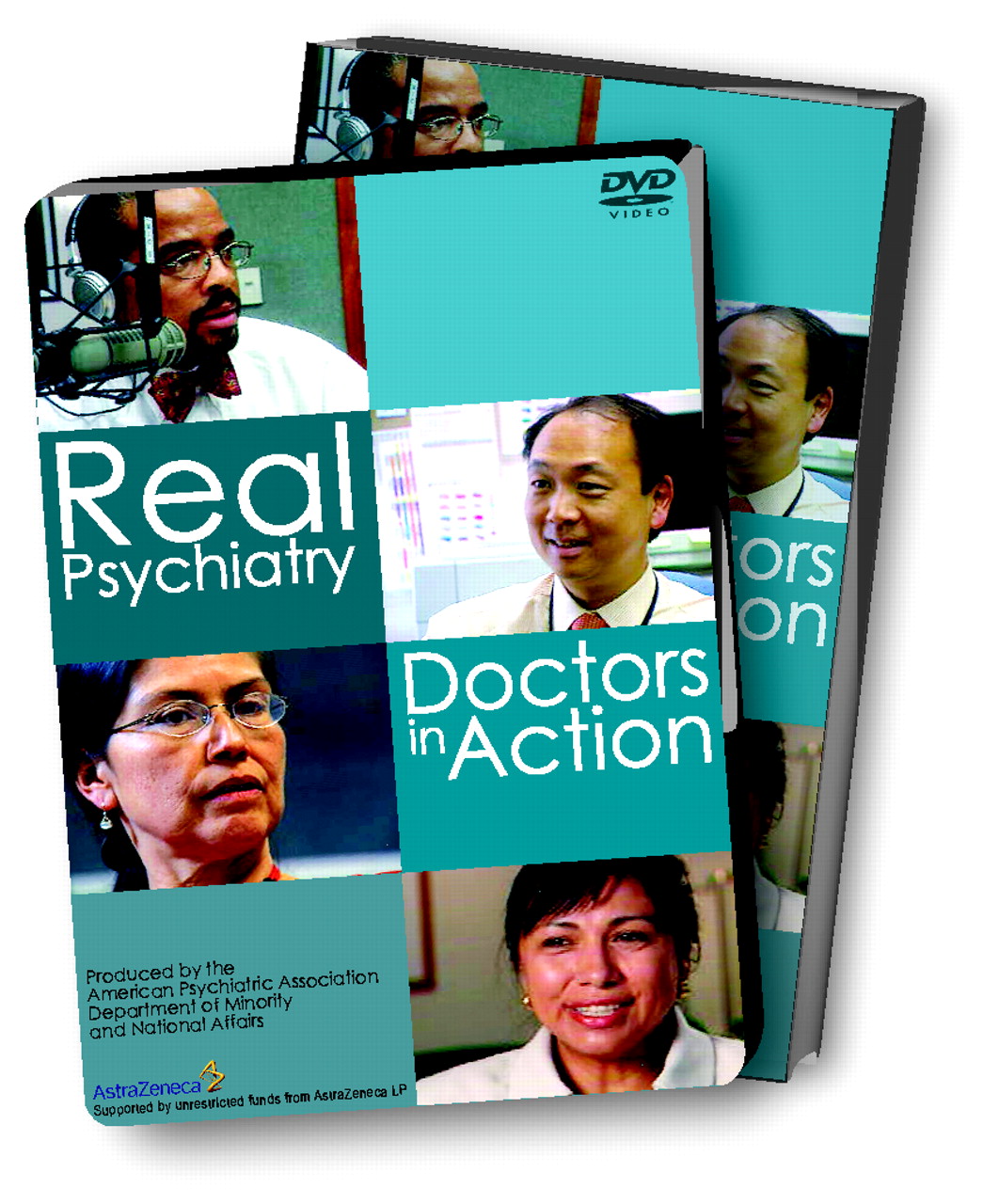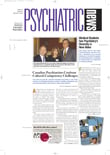Four psychiatrists are the stars of a new video documentary from APA in which the camera follows each through an average day in practice in settings ranging from an Indian pueblo north of Santa Fe, N.M., to a ramshackle apartment building in Baltimore.
The 27-minute video, “Real Psychiatry: Doctors in Action,” is an initiative of APA's Department of Minority and National Affairs. Its goal is to increase the number of minority psychiatrists and raise awareness about mental health issues in patients from different ethnic backgrounds.
Through the video, viewers gain some insights into each of the psychiatrist's professional and personal lives.
“`Real Psychiatry' is a valuable recruitment tool for psychiatry,” said Annelle Primm, M.D., M.P.H., director of the Department of Minority and National Affairs.
Primm said she thinks medical students and others belonging to underrepresented groups will identify with the diversity of the psychiatrists in the video and “be enticed to consider careers in psychiatry.”
Primm said the videotape “has tremendous potential to increase diversity in the psychiatric profession, which we know can help reduce mental health disparities among marginalized groups” and “helps to place psychiatry in a favorable light as a medical specialty, demystify the profession, and reduce the stigma of mental illness.”
The following psychiatrists are featured in the film, which was produced and directed by Ginny Durrin of Durrin Productions Inc. in Washington, D.C.
Psychiatrists Save Lives
During a typical week, Curtis Adams, M.D., has the capacity to reach as many as 60,000 people—though admittedly, the majority of these aren't his patients.
In addition to his roles as an assistant professor in the University of Maryland's Division of Community Psychiatry, senior psychiatrist at the Carruthers Clinic in Baltimore, and member of the Programs for Assertive Community Treatment (PACT) team at the University of Maryland, he can be heard on the radio discussing mental health issues and how they impact African Americans.
Each Wednesday afternoon, Adams takes his seat at the microphone as a guest on the radio show “Mind, Money, and Medicine” on WOL 1450-AM in the Baltimore-Washington, D.C., area. During the weekly broadcast, Adams has a chance to teach the public about what psychiatrists do when they treat patients.
“I know there is a lot of stigma surrounding mental illness,” Adams explains in the video. “But this is no different from having heart disease or hypertension—we're talking about the presence or absence of an illness, and if it's an illness, we can treat it.”
As a member of the Maryland PACT team, Adams is filmed climbing the stairs of a rundown apartment building to give one of his patients a monthly injection of antipsychotic medication.
Of his surroundings, Adams says, “These folks are at the mercy of competing challenges—people selling drugs in their neighborhoods and an overabundance of liquor stores. It's very difficult.”
In his role as senior psychiatrist at Carruthers Clinic, Adams can be seen removing sutures, giving injections, and taking blood from patients. “We do primary care, essentially,” he said of his work there.
“People don't think we are in the business of saving lives in psychiatry, and we absolutely are,” he added. “Many psychiatric illnesses carry a risk of death by suicide—so if you are able to intervene and prevent suicide, that is lifesaving.”
Adams told Psychiatric News he became a psychiatrist because“ I love people's stories... .I love to know where people come from and maybe have an influence on where they are headed.”
Adams has two children and thinks of psychiatry as a “family-oriented specialty.... We allow one another to be good parents,” he said.
Psychiatry Runs in Family
Having a positive impact on her patients is also one of the most satisfying parts of the job for Mercedes Martinez, M.D., a child and adolescent psychiatrist in Chicago.
“I've always said if I can help one child turn his or her life around, I've done something productive,” she said in an interview with Psychiatric News.
Martinez said she has always been fascinated by child development and has three children of her own who keep her grounded.
In addition to her role as a clinical assistant professor of psychiatry at the Rosalind Franklin University of Medicine and Science (formerly known as Chicago Medical School) and senior fellow with the National Center for Health Behavioral Change at Morgan State University in Baltimore, Martinez works at several Chicago-area health clinics, including Circle Family Care Health Clinic and Salud Family Health Care Clinic, where she trains family practice residents.
She also works at Allendale, a residential facility in Lake Villa, Ill., for children and adolescents with serious emotional disturbances.
Martinez said there is an urgent need for child and adolescent psychiatrists in inner-city and rural areas, especially those who are bilingual and understand the issues faced by minority youth with mental illnesses. “Universities need to be held accountable for recruiting, retaining, and graduating Hispanic doctors,” she said, “especially in the area of child and adolescent psychiatry.”
Psychiatry is in Martinez's blood, one might say.
Her father, Emilio Espindola, M.D., completed his psychiatry training in Mexico before coming to the United States at a time when accreditation from foreign medical schools was not accepted by U.S. programs. “He loved psychiatry so much that he completed a second residency in the U.S.,” Martinez explained.
Part of her childhood was spent on the grounds of a state hospital in Elgin, Ill., one of the places where Espindola practiced.
“Seeing how much his patients loved him and how much he gave of himself to the community” inspired her to pursue a medical career in psychiatry, she said.
Practicing Without Reservation
Two father figures from different worlds propelled Mary Roussel, M.D., down the path to a psychiatry career. The first was her grandfather, a Navajo medicine man, and the second was famed psychiatrist Karl Menninger, M.D., who founded the Menninger Clinic in Topeka, Kan., and died in 1990.
Menninger was fascinated with the Navajo healing process, Roussel said, and began a professional relationship with Roussel's father, who was director of an Indian education center at Arizona State University.
Menninger soon became a family friend, and Roussel said she can remember him conversing with her grandfather with the help of an interpreter about the art of Navajo healing.
According to Roussel, Navajo medicine involves ensuring that “mind and body are in harmony, and people are in harmony with the world around them.”
So it was not a leap for Roussel, as a Navajo woman, to enter a medical specialty in which treatment takes into account mind, body, and spirituality, she said. She is also married to a psychiatrist.
Roussel treats American Indian patients from different tribes at the Santa Fe Indian Hospital. She also works at clinics associated with the hospital, such as the Santa Clara Clinic, which is adjacent to the Santa Clara Pueblo reservation, 30 miles north of Santa Fe.
In addition, she is chair of the steering committee on Native American Psychiatry at the University of New Mexico.
Roussel encouraged American Indians to get involved in medicine, and in particular psychiatry.
She noted that although nonnative physicians come to practice on Indian reservations, “they are not familiar with Native-American people and have never lived on a reservation... .These things are hard for them to get used to,” Roussel said.
Many leave the reservations after a year or so, and as a result Native-American patients lack much-needed continuity of care, she added.
Stimulating the Intellect
Lowell Tong, M.D., a psychiatrist in the San Francisco area, said the“ fascinating and intellectually challenging” experiences with patients he encountered as a medical student at the University of Virginia made his decision to enter psychiatry an easy one.
For instance, during one of his psychiatry rotations, he met a patient who had a deeply held delusion about a certain facial feature and spent hours scrutinizing himself in the mirror.
Tong recalled the patient as a “polite and well-put-together kind of person who was otherwise coherent.” Tong recalled, “I thought in my own naive way—`this guy isn't really that sick. Let me just sit down with him and correct his misunderstanding.'”
Soon Tong realized the depth and intractability of the patient's delusion, which was related to other psychotic symptoms.
“Everything else I learned as a medical student made too much sense to me,” Tong told Psychiatric News. “I knew everything about bacteria, and I understood blood cells,” he recalled. “But no one could explain why he had this delusion, and I was challenged intellectually in a way I'd never been before.”
Tong enjoys his roles at the University of California, San Francisco, as a clinical professor of psychiatry, director of medical student education in psychiatry, and principal career advisor for medical students who are interested in psychiatry. “My goal is to give all students a solid understanding of psychiatry,” he said.
He also enjoys life outside of work with his partner, Alasdair Neale, a symphony conductor. “We're both very busy but cherish the time we have together,” Tong said.
A free copy of “Real Psychiatry: Doctors in Action” is available by calling APA toll free at (888) 35-PSYCH or sending an e-mail request to [email protected]. Each additional copy of the video costs $10 for VHS and $15 for DVD. APA members can also view the video on APA's Web site at<www.psych.org>.▪

